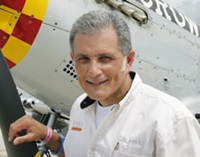

Warren Silberman
- Former Manager, FAA Aerospace Medical Certification
- Doctor of Osteopathic Medicine
- Expert in Aerospace/Preventive Medicine
- Pilot since 1986
To have you understand a few things, I need to teach you some medicine. All pilots are required to have periodic eye examinations, at least at the time of the FAA physical exam. The name of the chart that has the numbers in rows is called a Snellen chart. So, what does it mean when your physician informs you that your vision is 20/20? It means that you can see at 20 feet what a normal person sees at 20 feet. 20/20 Snellen Visual acuity is considered "normal," though many people can see better than that. The FAA only requires a person to be able to "correct" to the vision standard appropriate for the class of medical applied for, meaning there are no "uncorrrected" vision acuity standards. Being able to "correct" to some vision simply means that your eyes are being corrected with contact lenses or eyeglasses.
Someone with 20/200 vision needs to be at 20 feet to see what a normal person sees at 200 ft. to be “monocular.” This would be so even if the pilot was wearing glasses in an attempt to improve their visual acuity.
So, other than not being able to see well out of the "bad" eye, what is the other significance of being monocular? The brain uses your two eyes to be able to tell the spatial difference between objects. The experts say that this is only adequate up to about a 50 foot distance. The medical term for this is "stereopsis." To explain this a bit more, this means the ability to tell that another airplane that may be parked next to a different airplane is not only next to but one row in front of the other airplane. As you can surmise, this is important when you are taxiing or pehaps having to make an emergency landing in a field with trees spread out in it.
There are people who may become monocular in a short period of time, such as developing a tumor in the eye that requires surgical removal of the globe, or in a much slower process such as hemorrhage into the retina for some reason that results in a slower deterioration of vision. This is important because the FAA requires a six-month period of "adjustment" to allow time for the brain to adjust to what the physicians call the "monocular clues." A person who either suddenly goes from normal visual acuity in the one eye to something worse than 20/200 must wait six months before applying for a waiver so the brain can adjust to seeing objects out of the single eye. If the visual acuity is lost over a gradual period of time greater than six months, the waiver application process can begin as soon as the monocular vision diagnosis is established. The type of "waiver" that such pilots are issued is called a SODA, or statement of demonstrated ability, and is issued following the successful completion of a medical flight test, conducted through the local flight standards district office.
As of Dec. 31, 2011, there were 278 first-class airmen, 374 second-class, and 1,328 third-class airmen with a monocular vision waiver. There were approximately 600,000 airmen with medical certificates that year.
For more information on the AOPA Pilot Protection Services program, visit www.aopa.org/pps.
To continue reading, please log in or join AOPA now to have access to these exclusive expert resources.
Hopefully you all know the famous aviator Wiley Post. He was from Oklahoma and was the first pilot to fly solo around the world. Post developed one of the first pressure suits and discovered the existence of the jet stream. On Aug. 15, 1935, Post and the American humorist Will Rogers were killed when Post's aircraft crashed on takeoff from a lagoon near Point Barrow in Alaska. In case you don't recall, he had previously lost vision in one of his eyes, so that brings me to the reason for my article this time. I am going to explain how the FAA manages what is known as a "monocular" vision.


